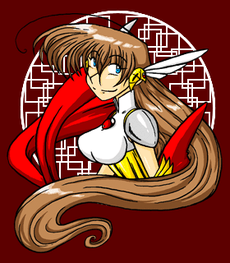Gender and webcomics
In contrast with mainstream American comics, webcomics are primarily written and drawn by women and gender variant people. Because of the self-published nature of webcomics, the internet has become a successful platform for social commentary, as well as lesbian, gay, bisexual, and transgender (LGBT) expression.
Statistics
A 2015 study by David Harper concluded that webcomics were vastly more popular format to female, transgender, and non-binary comic artists than for men. More than 40% of the women, transgender, and non-binary comic artists reported to work primarily in webcomics in this study, while only 15% of men did. Harper suggested that this may be because the self-published nature of webcomics form a lower barrier to entry, while traditional mediums such as comic books are gatekept by cisgender men, though he also suggested that this disparity may just be a difference in interest between the groups.[1]
According to a study by Erik Melander in 2005, at least 25% of webcomic creators were female. This percentage was significantly larger than the number of successful women creating print comics at the time, and the number may have been even higher, as a certain percentage of contributors were unknown.[2] In 2015, 63% of the top 30 comic creators on webcomic conglomerate Tapastic was female.[3]
Women in webcomics
Girls with Slingshots creator Danielle Corsetto stated that webcomics are probably a female dominated field because there is no need to go through an established publisher. Noelle Stevenson, creator of Nimona and Lumberjanes, noticed that webcomics predominantly feature female protagonists, possibly to "balance out" the content of mainstream media. Corsetto noted that she has never encountered sexism during her career, though Stevenson described some negative experiences with Reddit and 4Chan, websites outside of her usual channels.[5]
Oliver Sava of The A.V. Club pointed out that there exists a growing community of black women cartoonists creating webcomics.[6]
In India, where rape of women has been a big issue in recent years, Indian webcomics formed a platform for artists to poke fun at patriarchy, feminism, and various other gender-related topics. According to human rights activist and webcomic creator Rachita Taneja, humor aids in communicating complex subjects to large groups of people, and the inclusiveness of webcomics makes it an excellent medium for said communication.[4][7]
Girlamatic was a subscriber-based webcomic site founded by Joey Manley in 2003. The website's purpose was to syndicate webcomics created primarily by women and marketed primarily to women. Girlamatic included webcomics created by various well-known female webcomic artists, including Shaenon Garrity and Lea Hernandez. The syndicate had won various Lulu awards for being among the "most women-friendly and reader- friendly work in comics."[8] Writing for Comixpedia, Eric Burns voiced his worries that initiatives like Girlamatic section off and divide the webcomic community, making it less likely for male readers to come across the works of female webcartoonists.[9]
LGBT in webcomics

There exist a large amount of openly gay and lesbian comic creators that self-publish their work on the internet. These include amateur works, as well as more "mainstream" works, such as Kyle's Bed & Breakfast.[10] According to Andrew Wheeler from Comics Alliance, webcomics "provide a platform to so many queer voices that might otherwise go undiscovered,"[11] and Tash Wolfe of The Mary Sue has a similar outlook on transgender artists and themes.[12]
See also
References
- 1 2 Guzdam, de, Jennifer (2015-06-23). "Where's the Money in Comics? This Survey Breaks it Down by Gender". Comics Alliance.
- ↑ Bovri, Bart (2011). ""Man, you split wood like a girl." Gender Politics In "Y: The Last Man"" (PDF). Universiteit Gent.
- ↑ Rosser, Emma (2015-12-17). "A comic book revolution from the man that brought Google to Korea". The Sociable.
- 1 2 Sanyal, Pathikrit (2016-03-01). "Stick-figure activism: A clever webcomic that talks about everything that's wrong with our country". IBN Live.
- ↑ Campbell, Josie (2013-03-29). "Women in Comics: Stevenson & Corsetto on Webcomics and the Future". Comic Book Resources.
- ↑ Sava, Oliver (2016-02-19). "Agents Of The Realm, M.F.K., and the ascent of black women in webcomics". The A.V. Club.
- ↑ Choksi, Nidhi (2015-12-13). "A new superhero has emerged, the web comic". Hindustan Times.
- ↑ "Lulu Awards". Friends of Lulu.
- ↑ Burns, Eric (2005-04-17). "Feeding Snarky". Comixpedia. Archived from the original on 2005-04-19.
- ↑ Palmer, Joe (2006-10-16). "Gay Comics 101". AfterElton.com. p. 3. Archived from the original on 2007-10-15.
- ↑ Wheeler, Andrew (2012-06-29). "Comics Pride: 50 Comics and Characters That Resonate with LGBT Readers". Comics Alliance.
- ↑ Wolfe, Tash (2015-02-23). "Visual Representation: Trans Characters In Webcomics". The Mary Sue.
